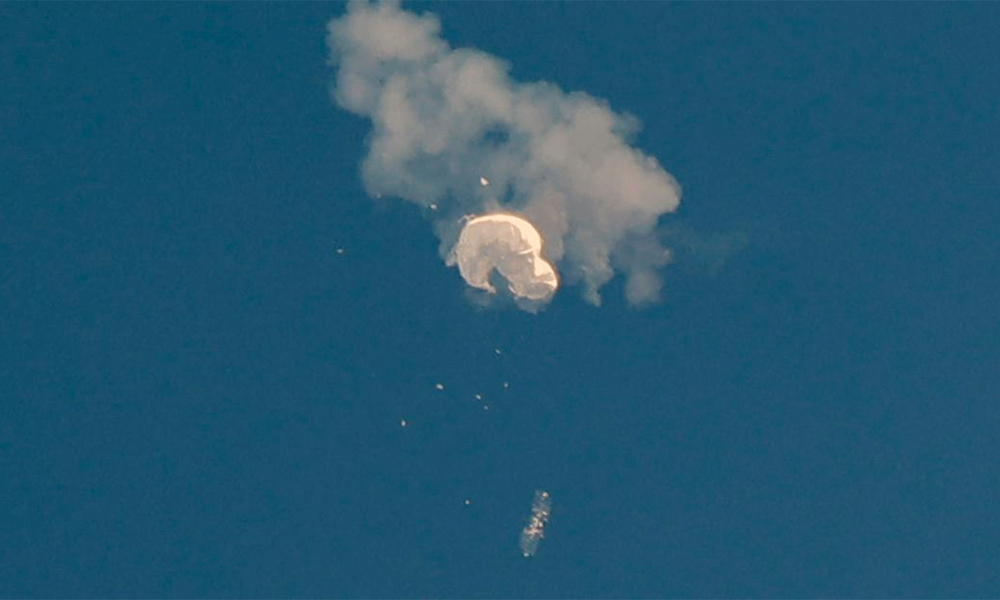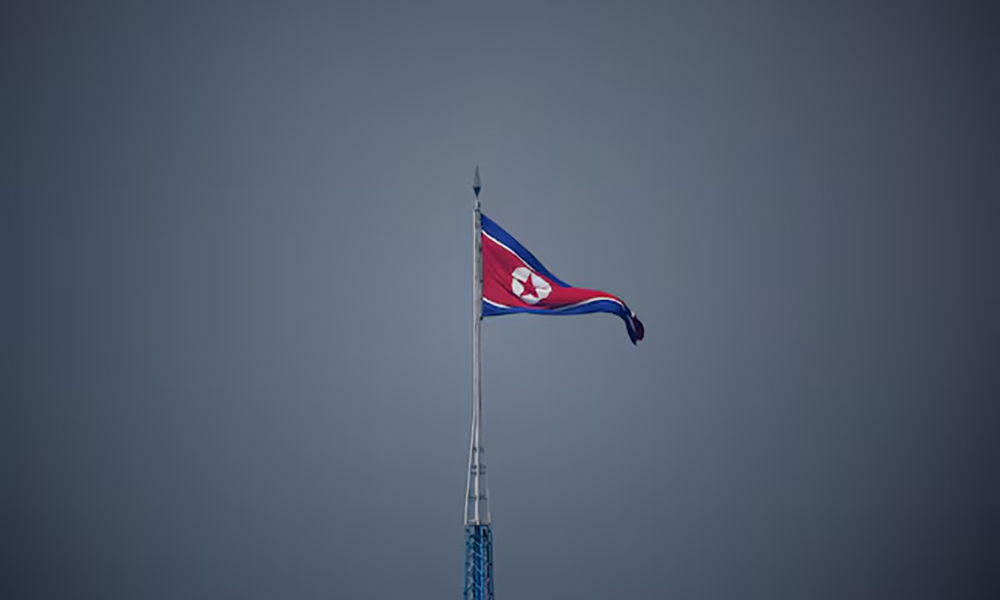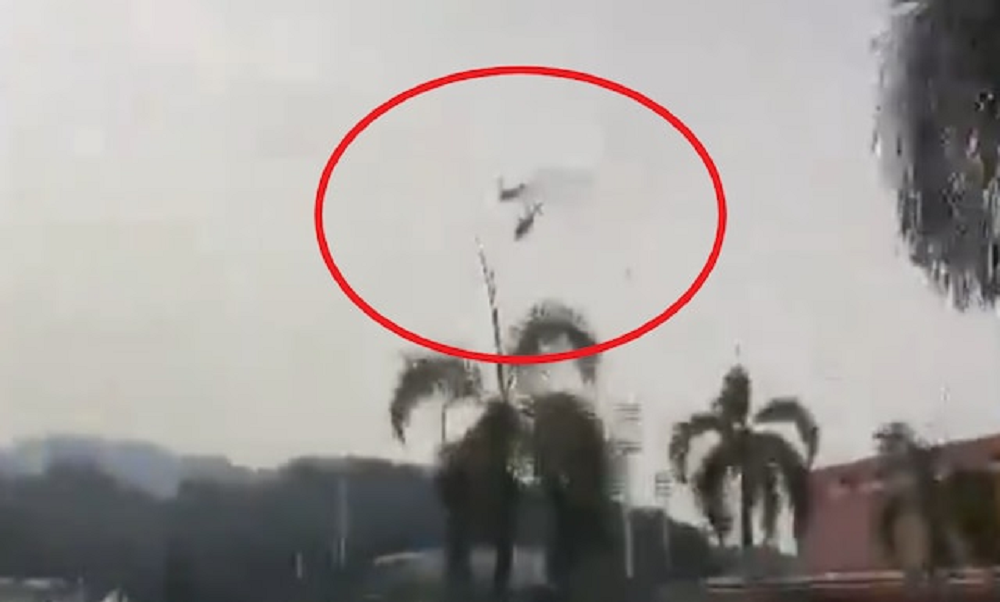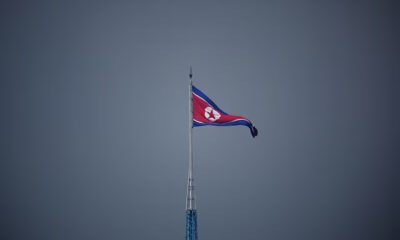World
US fighter jet shoots down suspected Chinese spy balloon

A US military fighter jet shot down a suspected Chinese spy balloon off the coast of South Carolina on Saturday, a week after it first entered US airspace and triggered a dramatic — and public — spying saga that worsened Sino-US relations, Reuters reported.
President Joe Biden said he had issued an order on Wednesday to take down the balloon, but the Pentagon had recommended waiting until it could be done over open water to safeguard civilians from debris crashing to Earth from thousands of feet (meters) above commercial air traffic.
“They successfully took it down, and I want to compliment our aviators who did it,” Biden said.
Multiple fighter and refueling aircraft were involved in the mission, but only one — an F-22 fighter jet from Langley Air Force Base in Virginia — took the shot at 2:39 p.m. (1939 GMT), using a single AIM-9X supersonic, heat-seeking, air-to-air missile, a senior US military official said.
According to Reuters China strongly condemned the military strike on an airship that it says was used for meteorological and other scientific purposes, and which it said had strayed into US airspace “completely accidentally” — claims flatly dismissed by US officials.
“China had clearly asked the US to handle this properly in a calm, professional and restrained manner,” China’s foreign ministry said in a statement. “The US had insisted on using force, obviously overreacting.”
The balloon was shot down about six nautical miles off the US coast of the Atlantic Ocean, over relatively shallow water, potentially aiding efforts to recover elements of the Chinese surveillance equipment over the coming days, US officials said.
One US military official said the debris field was spread out over seven miles (11 km) of ocean, and multiple US military vessels were on site.
The downing of the balloon came shortly after the US government ordered a halt to flights in and out of three airports in South Carolina — Wilmington, Myrtle Beach and Charleston — due to what it said at the time was an undisclosed “national security effort.” Flights resumed on Saturday afternoon, Reuters reported.
While Saturday’s shootdown concludes the military dimension to the spying saga, Biden is likely to continue to face intense political scrutiny from Republican opponents in Congress who argue he failed to act quickly enough.
A senior administration official said after shooting down the balloon, the US government spoke directly with China about the action. The State Department also briefed allies and partners around the world, the official said.
Questions remain about how much information China may have gathered during the balloon’s trek across the United States, read the report.
The balloon entered US airspace in Alaska on Jan. 28 before moving into Canadian airspace on Jan 30. It then re-entered US airspace over northern Idaho on Jan. 31, a US defense official said. Once it crossed over US land, it did not return to open waters, making a shootdown difficult.
US officials did not publicly disclose the balloon’s presence over the United States until Thursday, Reuters reported.
“It’s clear the Biden administration had hoped to hide this national security failure from Congress and the American people,” said US Representative Mike Rogers, a Republican who leads the House of Representatives Armed Services Committee.
Biden’s emphasis on Saturday that — days ago — he ordered the balloon shot down as soon as possible could be an effort to respond to such critics.
Former President Donald Trump, Biden’s potential rival in the 2024 election, called earlier this week for the balloon to be shot down, and has sought to portray himself as stronger than Biden on China. The US relationship with China is likely to be a major theme of the 2024 presidential race.
Washington had called the balloon’s appearance a “clear violation” of US sovereignty and notified Beijing about the shootdown on Saturday, a US official said.
Still, officials on Saturday appeared to play down the balloon’s impact on US national security.
“Our assessment — and we’re going to learn more as we pick up the debris — was that it was not likely to provide significant additive value over and above other (Chinese) intel capability, such as satellites in low-Earth orbit,” the senior US defense official said.
A Reuters photographer who witnessed the shootdown said a stream came from a jet and hit the balloon, but there was no explosion. It then began to fall.
The Pentagon assesses that the balloon was part of a fleet of Chinese spy balloons. On Friday, it said another Chinese balloon was flying over Latin America.
“Over the past several years, Chinese balloons have previously been spotted over countries across five continents, including in East Asia, South Asia and Europe,” the US official said.
The suspected spy balloon prompted Secretary of State Antony Blinken to postpone a visit to China this week that had been expected to start on Friday, Reuters reported.
The postponement of Blinken’s trip, which had been agreed to in November by Biden and Chinese President Xi Jinping, was a blow to those who saw it as an overdue opportunity to stabilize an increasingly fractious relationship between the two countries.
China is keen for a stable US relationship so it can focus on its economy, battered by the now-abandoned zero-COVID policy and neglected by foreign investors alarmed by what they see as a return of state intervention in the market.
World
North Korea officials visit Iran in a rare public trip

A North Korean delegation led by the cabinet minister for international trade is visiting Iran, the North’s official media said on Wednesday in a rare public report of an exchange between the two countries believed to have secret military ties, Reuters reported.
The minister for external economic relations, Yun Jong Ho, left Pyongyang on Tuesday by air leading a ministry delegation to visit Iran, the North’s KCNA news agency said. It gave no other detail.
North Korea and Iran have long been suspected of cooperating on ballistic missile programmes, possibly exchanging technical expertise and components that went into their manufacture, read the report.
Iran has provided a large number of ballistic missiles to Russia for use in its war with Ukraine, Reuters reported in February.
North Korea is also suspected of supplying Russia with missiles and artillery, although both countries have denied the allegation.
Yun has previously worked on the country’s ties with Syria, according to South Korean government database.
Yun has been active in the country’s increasing exchanges with Russia, earlier this month leading a delegation to visit Moscow, according to KCNA.
World
Malaysian navy helicopters collide in mid-air, 10 killed

Two Malaysian navy helicopters collided in mid-air during a rehearsal for a naval parade on Tuesday, killing all 10 crew members aboard, the navy said in a statement.
The incident occurred at the Lumut naval base in the western state of Perak at 9.32 a.m. on Tuesday morning, the navy said.
“All victims were confirmed dead at the scene and sent to the Lumut naval base military hospital for identification,” Reuters reported the navy as saying.
A video circulating on local media showed several helicopters flying in formation, when one of the choppers’ rotor clipped another before both aircraft crashed into the ground.
Local police confirmed the footage was genuine.
The navy said it would carry out an investigation into the cause of the accident, Reuters reported.
Defence Minister Mohamed Khaled Nordin said the aircraft – a maritime operations helicopter and a Fennec military chopper – were rehearsing for a parade celebrating the 90th anniversary of the Royal Malaysian Navy, due to be held on Saturday.
Efforts were underway to verify the identities of the crew members killed, all of whom were below the age of 40, Mohamed Khaled told reporters.
World
Russia says West is teetering on brink of conflict between nuclear powers

Russian Foreign Minister Sergei Lavrov said on Monday that the support of the United States, Britain and France for Ukraine was stoking serious strategic risks that had raised the risk of a direct confrontation between the world’s biggest nuclear powers.
Lavrov said the United States and NATO were obsessed with the idea of inflicting “strategic defeat” on Russia and there were risks in such confrontation that could lead to an increased level of nuclear danger, Reuters reported.
“The Westerners are teetering dangerously on the brink of a direct military clash between nuclear powers, which is fraught with catastrophic consequences,” Lavrov said.
The United States and its allies say they are helping Ukraine to defend itself against Russian aggression and that it is Russia that is aggravating East-West tensions, including by issuing repeated warnings about the danger of a nuclear conflict.
Lavrov said: “Of particular concern is the fact that it is the ‘troika’ of Western nuclear states that are among the key sponsors of the criminal Kyiv regime, the main initiators of various provocative steps. We see serious strategic risks in this, leading to an increase in the level of nuclear danger.”
The three Western countries with nuclear weapons are the United States, Britain and France.
-

 Sport5 days ago
Sport5 days agoRashid Khan threatens BBL pullout after Australia postpones Afghanistan T20I series
-

 Business5 days ago
Business5 days agoCommerce ministry inks 10 MoUs to boost development of small and medium-sized businesses
-

 Latest News5 days ago
Latest News5 days agoOver 6,000 acres of land cleared of poppies in Badakhshan
-

 Latest News5 days ago
Latest News5 days agoMSF ‘deeply concerned’ over new phase of deportations of Afghans from Pakistan
-

 Sport4 days ago
Sport4 days agoAfghanistan Champions League kicks off with grand opening ceremony
-

 Latest News3 days ago
Latest News3 days agoPakistan’s frontiers minister stresses ‘dignified’ return of Afghan refugees
-

 Regional4 days ago
Regional4 days agoIran’s foreign minister downplays drone attack, says Tehran investigating
-

 Latest News5 days ago
Latest News5 days agoTen people killed by floods in Helmand
























